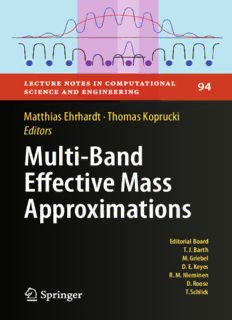Table Of Content94
Matthias Ehrhardt · Thomas Koprucki
Editors
Multi-Band
Eff ective Mass
Approximations
Editorial Board
T. J.Barth
M.Griebel
D.E.Keyes
R.M.Nieminen
D.Roose
T.Schlick
Lecture Notes
in Computational Science 94
and Engineering
Editors:
TimothyJ. Barth
MichaelGriebel
DavidE. Keyes
RistoM. Nieminen
DirkRoose
TamarSchlick
Forfurthervolumes:
http://www.springer.com/series/3527
Matthias Ehrhardt Thomas Koprucki
(cid:2)
Editors
Multi-Band Effective
Mass Approximations
Advanced Mathematical Models
and Numerical Techniques
123
Editors
MatthiasEhrhardt ThomasKoprucki
LehrstuhlfürAngewandte Forschungsgruppe“Partielle
MathematikundNumerischeAnalysis Differentialgleichungen”
BergischeUniversitätWuppertal Weierstraß-InstitutfürAngewandte
Wuppertal,Germany AnalysisundStochastik
Berlin,Germany
ISSN1439-7358 ISSN2197-7100(electronic)
ISBN978-3-319-01426-5 ISBN978-3-319-01427-2(eBook)
DOI10.1007/978-3-319-01427-2
SpringerChamHeidelbergNewYorkDordrechtLondon
LibraryofCongressControlNumber:2014943912
MathematicsSubjectClassification(2010):34L40,35J10,35Q41,65L15,65N06,65N30,81Q05
(cid:2)c SpringerInternationalPublishingSwitzerland2014
Thisworkissubjecttocopyright.AllrightsarereservedbythePublisher,whetherthewholeorpartof
thematerialisconcerned,specificallytherightsoftranslation,reprinting,reuseofillustrations,recitation,
broadcasting,reproductiononmicrofilmsorinanyotherphysicalway,andtransmissionorinformation
storageandretrieval,electronicadaptation,computersoftware,orbysimilarordissimilarmethodology
nowknownorhereafterdeveloped.Exemptedfromthislegalreservationarebriefexcerptsinconnection
with reviews or scholarly analysis or material supplied specifically for the purpose of being entered
and executed on a computer system, for exclusive use by the purchaser of the work. Duplication of
this publication or parts thereof is permitted only under the provisions of the Copyright Law of the
Publisher’slocation,initscurrentversion,andpermissionforusemustalwaysbeobtainedfromSpringer.
PermissionsforusemaybeobtainedthroughRightsLinkattheCopyrightClearanceCenter.Violations
areliabletoprosecutionundertherespectiveCopyrightLaw.
Theuseofgeneraldescriptivenames,registerednames,trademarks,servicemarks,etc.inthispublication
doesnotimply,evenintheabsenceofaspecificstatement,thatsuchnamesareexemptfromtherelevant
protectivelawsandregulationsandthereforefreeforgeneraluse.
While the advice and information in this book are believed to be true and accurate at the date of
publication,neithertheauthorsnortheeditorsnorthepublishercanacceptanylegalresponsibilityfor
anyerrorsoromissionsthatmaybemade.Thepublishermakesnowarranty,expressorimplied,with
respecttothematerialcontainedherein.
Printedonacid-freepaper
SpringerispartofSpringerScience+BusinessMedia(www.springer.com)
Foreword
With the rapid development of nano sciences, the structural properties of semi-
conductors can be arranged on an atomic scale. This has led to massive down
scalingofelectronicintegratedcircuits,compactsemiconductorlightsourceswith
highest power densities, and tiny sensors that monitor various physical properties
in complex environments.This developmentwill continue in the future, and with
ongoing progress in the synthesis of complex nanostructures, the inclusion of a
wider field of chemical elements and as result even more functionality and better
performancewillbefeasible.
At the heart of understanding the electronic, optical, or magnetic properties
in nanostructures is the dispersion relation for electrons and holes. It represents
a quantum mechanical property of the electron, namely the energy versus its
wave vector. The latter can also be viewed as momentum, using the de Broglie
relation. The dispersion relation contains a plethora of information, namely the
phase velocity (which in classical electromagnetics is related to the refractive
index),thegroupvelocity,andtheeffectivemass,onlytonamefew.Infreespace,
solvingSchrödinger’sequationforasingleelectrongivesthewell-knownparabolic
dispersionrelation. Now if the electronis located in a semiconductorcrystal, it is
surroundedbyaperiodicarrangementofnuclei,alargenumberofcoreandvalence
electrons.InclusionoftherespectivepotentialsintheHamiltonianleadstoalarge
coupled many-particle quantum mechanical problem, which, for nanostructures,
cannotbesolvedwithcurrentnumericaloranalyticalmethods.
It is due to three formidable approximations that we can study the physical
properties of nanostructures with the sophisticated mathematical and numerical
methodsthatarepresentedinthisbook.First,thecoreelectronsofthefullyoccupied
orbitalscan be lumpedtogetherwith the nuclei,whichleads to potentialsof ionic
cores. This removesall the equationsfor the core electrons from the system. The
next simplification is called Born-Oppenheimer approximation: the ion cores are
much heavier than the remaining valence electrons. Therefore, they move much
slowerandarebasicallystationarytotheelectrons.Asaconsequence,theelectronic
v
vi Foreword
propertiescan be calculated using fixed nuclei positions, and the nucleidynamics
can be separated into an interactionHamiltonian.Atlast, the so-calledmean field
approximationtreatsallvalenceelectrons(excepttheelectronofinterest)asaverage
backgroundpotential.Thatway,theelectron–electroncouplingcanbetreatedbya
singleuncoupledeffectivepotential,andtheremainingequationresemblesasingle
particleSchrödingerequation.
A fundamental property of this single particle equation for crystals is the
periodicityoftheioniccorepotentials,whichleadsdirectlytoBlochwavefunctions
as solutions, and a separation of the Hamiltonian into a part independent of the
wave vector and dependent on the wave vector, containing a k(cid:3)p term (therefore
the name k(cid:3)p is sometimes used for this equation). The presence of the periodic
potentialintroducesbandgapsinthedispersionrelationandaplethoraofsignificant
deviations from the free-electron case. Time-dependentor stationary perturbation
theorycanbeappliedtosolvethe k(cid:3)p Schrödingerequationin anelegantfashion,
where the terms containing the wave vector are treated again as perturbation
in the Hamiltonian. Hence, the solution is more exact for small wave vector
magnitudes, depending on the order of perturbation included. In order to study
realistic nanostructures, many more perturbations need to be added to the single
particle Hamiltonian. These perturbations and the mathematics and numerics to
solve the resulting Schrödingerequation is the subject of this book. They include
theband-to-bandcoupling,spin–orbitinteraction,thepresenceofheterointerfaces,
mechanicalstrain, and surfaces or carrier scattering and their statistics. This way,
the electronic dispersion relation (band structure) or even the carrier dynamics
of complex semiconductor nanostructures can be calculated with high numerical
efficiency. It gives us information such as the effective masses, the strength and
energiesofopticaltransitionsorthe spin–orbitinteraction,or thedensityofstates
forchargecarriers,whichareoffundamentalimportancetounderstandelectronic,
optical,ormagneticpropertiesinnanodevices.
The book starts with three chapters on the physical models, from a multi-
band description aiming at quantum transport properties of carriers within the
multi-bandformalism,to a focuson state-of-the-artk(cid:3)pmodelsforquantumdots,
emphasizing symmetry considerations. The second part is devoted to numerical
methods for solving the k(cid:3)p type equation framework, with one chapter on the
finiteelementmethod,andthesecondoneontheplanewaveexpansion.Inthethird
part, applications of the k(cid:3)p method are presented, demonstrating the capabilities
of the framework for describing challenging but nonetheless realistic situations
in band structure calculations. In the final chapter, advanced mathematical topics
are discussed, such as a time-dependent effective mass multi-band formalism
dealingwithcarrierdynamics,andthetopicoftransparentboundaryconditionsfor
terminationofthesimulationdomain.
The reader of this book will gain a detailed insight into the status of the
multi-bandeffectivemassmethodforsemiconductornanostructures.Bothusersof
the k(cid:3)p method and advanced researchers who want to advance the k(cid:3)p method
Foreword vii
furtherwillfindhelpfulinformationtoworkwiththismethodanduseitasatoolto
characterizethephysicalpropertiesofsemiconductornanostructures.
Kassel,Germany BerndWitzigmann
June2014
Preface
The operationalprincipleof modernsemiconductornanostructures,such as quan-
tumwells,quantumwires,orquantumdots,reliesonquantummechanicaleffects.
Thegoalofnumericalsimulationsusingquantummechanicalmodelsinthedevel-
opment of semiconductor nanostructures is threefold: First, they are needed for a
deeperunderstandingofexperimentaldataandoftheoperationalprinciple.Second,
istopredictandoptimizeinadvancequalitativeandquantitativepropertiesofnew
devices in order to minimize the number of prototypes needed. Semiconductor
nanostructuresareembeddedasanactiveregioninsemiconductordevices.Finally,
theresultsofquantummechanicalsimulationsofsemiconductornanostructurescan
beusedbyupscalingmethodstodeliverparametersneededinsemi-classicalmodels
forsemiconductordevicessuchasquantumwelllasers.Thisbookcoversindetail
allthesethreeaspectsusingavarietyofillustratingexamples.
Multi-band effective mass approximations have been increasingly attracting
interest over the last decades, since it is an essential tool for effective models in
semiconductormaterials.Thisbookisconcernedwithseveralmathematicalmodels
from the most relevant class of k(cid:3)p-Schrödinger Systems. We will present both
mathematical models and state-of-the-art numerical methods to solve adequately
the arising systems of differentialequations. The designated audience is graduate
andPh.D.studentsofmathematicalphysics,theoreticalphysicsandpeopleworking
inquantummechanicalresearchorsemiconductor/opto-electronicindustrywhoare
interestedinnewmathematicalaspects.
The principal audience of this book is graduate and Ph.D. students of (mathe-
matical) physics, research lecturer of mathematical physics, and research people
workinginsemiconductor,opto-electronicindustryforaprofessionalreference.
Wuppertal,Germany MatthiasEhrhardt
Berlin,Germany ThomasKoprucki
June2014
ix
Description:This book addresses several mathematical models from the most relevant class of kp-Schrödinger systems. Both mathematical models and state-of-the-art numerical methods for adequately solving the arising systems of differential equations are presented. The operational principle of modern semiconduct

